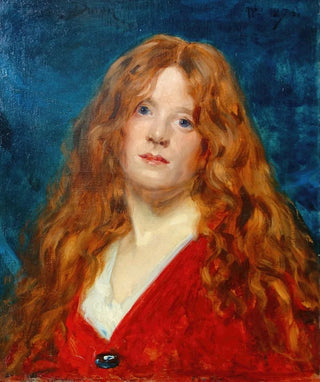Painting Portrait of a Red-haired Woman 1876 - Carolus-Duran | Art print


View from behind

Frame (optional)
Portrait of a Red-haired Woman 1876 - Carolus-Duran – Captivating Introduction
The "Portrait of a Red-haired Woman" by Carolus-Duran, created in 1876, is a work that transcends the simple frame of painting to become a true embodiment of elegance and feminine sensuality. In this painting, the artist manages to capture not only the physical beauty of his model but also an atmosphere charged with emotion and mystery. The depicted woman, with her fiery hair and penetrating gaze, seems almost alive, inviting the viewer to wonder about her story and thoughts. This portrait, emblematic of Duran's style, immerses us in a universe where each brushstroke tells a story, where each color evokes a sensation.
Style and uniqueness of the work
Carolus-Duran's style is characterized by an impressive mastery of light and color. In "Portrait of a Red-haired Woman," he uses warm tones that envelop the subject in an almost golden aura, accentuating the texture of the hair and the softness of the skin. The background, subtly blurred, allows the focus to remain on the central figure, creating a striking contrast. This technique, reminiscent of the Impressionists, is distinguished by precision in rendering details, especially in the woman's eyes and lips, which seem to vibrate with life. Duran does not merely reproduce an image; he creates an atmosphere, a palpable emotion emanating from the painting. This portrait is thus an ode to feminine beauty, but also an exploration of human psychology, revealing an unsuspected depth behind the radiant face of his model.
The artist and his influence
Carolus-Duran, born in 1837, was a French painter whose work had a significant influence on the artistic movement of his time. A student of great masters, he developed a style that combines realism and impressionism, standing out for his ability to capture the very essence of his subjects. Duran is also recognized for his role as a teacher, having trained many artists who would become major figures of modern art. His approach to portrait painting, which emphasizes individual expression and psychology, paved the way

Matte finish

View from behind

Frame (optional)
Portrait of a Red-haired Woman 1876 - Carolus-Duran – Captivating Introduction
The "Portrait of a Red-haired Woman" by Carolus-Duran, created in 1876, is a work that transcends the simple frame of painting to become a true embodiment of elegance and feminine sensuality. In this painting, the artist manages to capture not only the physical beauty of his model but also an atmosphere charged with emotion and mystery. The depicted woman, with her fiery hair and penetrating gaze, seems almost alive, inviting the viewer to wonder about her story and thoughts. This portrait, emblematic of Duran's style, immerses us in a universe where each brushstroke tells a story, where each color evokes a sensation.
Style and uniqueness of the work
Carolus-Duran's style is characterized by an impressive mastery of light and color. In "Portrait of a Red-haired Woman," he uses warm tones that envelop the subject in an almost golden aura, accentuating the texture of the hair and the softness of the skin. The background, subtly blurred, allows the focus to remain on the central figure, creating a striking contrast. This technique, reminiscent of the Impressionists, is distinguished by precision in rendering details, especially in the woman's eyes and lips, which seem to vibrate with life. Duran does not merely reproduce an image; he creates an atmosphere, a palpable emotion emanating from the painting. This portrait is thus an ode to feminine beauty, but also an exploration of human psychology, revealing an unsuspected depth behind the radiant face of his model.
The artist and his influence
Carolus-Duran, born in 1837, was a French painter whose work had a significant influence on the artistic movement of his time. A student of great masters, he developed a style that combines realism and impressionism, standing out for his ability to capture the very essence of his subjects. Duran is also recognized for his role as a teacher, having trained many artists who would become major figures of modern art. His approach to portrait painting, which emphasizes individual expression and psychology, paved the way
12,34 €






